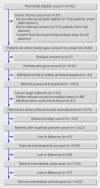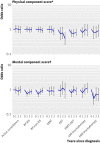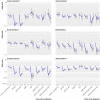Quality of life three years after diagnosis of localised prostate cancer: population based cohort study
- PMID: 19945997
- PMCID: PMC2784818
- DOI: 10.1136/bmj.b4817
Quality of life three years after diagnosis of localised prostate cancer: population based cohort study
Abstract
Objective: To quantify the risk and severity of negative effects of treatment for localised prostate cancer on long term quality of life.
Design: Population based, prospective cohort study with follow-up over three years.
Setting: New South Wales, Australia.
Participants: Men with localised prostate cancer were eligible if aged less than 70 years, diagnosed between October 2000 and October 2002, and notified to the New South Wales central cancer registry. Controls were randomly selected from the New South Wales electoral roll and matched to cases by age and postcode.
Main outcome measures: General health specific and disease specific function up to three years after diagnosis, according to the 12 item short form health survey and the University of California, Los Angeles prostate cancer index.
Results: 1642 (64%) cases and 495 (63%) eligible and contacted controls took part in the study. After adjustment for confounders, all active treatment groups had low odds of having better sexual function than controls, in particular men on androgen deprivation therapy (adjusted odds ratio (OR) 0.02, 95% CI 0.01 to 0.07). Men treated surgically reported the worst urinary function (adjusted OR 0.17, 95% CI 0.13 to 0.22). Bowel function was poorest in cases who had external beam radiotherapy (adjusted OR 0.44, 95% CI 0.30 to 0.64). General physical and mental health scores were similar across treatment groups, but poorest in men who had androgen deprivation therapy.
Conclusions: The various treatments for localised prostate cancer each have persistent effects on quality of life. Sexual dysfunction three years after diagnosis was common in all treatment groups, whereas poor urinary function was less common. Bowel function was most compromised in those who had external beam radiotherapy. Men with prostate cancer and the clinicians who treat them should be aware of the effects of treatment on quality of life, and weigh them up against the patient's age and the risk of progression of prostate cancer if untreated to make informed decisions about treatment.
Conflict of interest statement
Competing interests: None declared.
Figures




Comment in
-
Life after prostate cancer. Time to evaluate focal therapy.BMJ. 2010 Feb 23;340:c1057. doi: 10.1136/bmj.c1057. BMJ. 2010. PMID: 20179109 No abstract available.
-
[Patient quality of life three years after diagnosis of localized prostate cancer].Praxis (Bern 1994). 2010 Apr 14;99(8):503-4. doi: 10.1024/1661-8157/a000125. Praxis (Bern 1994). 2010. PMID: 20391358 German. No abstract available.
Similar articles
-
Fifteen year quality of life outcomes in men with localised prostate cancer: population based Australian prospective study.BMJ. 2020 Oct 7;371:m3503. doi: 10.1136/bmj.m3503. BMJ. 2020. PMID: 33028540 Free PMC article.
-
Patient-Reported Outcomes Through 5 Years for Active Surveillance, Surgery, Brachytherapy, or External Beam Radiation With or Without Androgen Deprivation Therapy for Localized Prostate Cancer.JAMA. 2020 Jan 14;323(2):149-163. doi: 10.1001/jama.2019.20675. JAMA. 2020. PMID: 31935027 Free PMC article.
-
Association Between Choice of Radical Prostatectomy, External Beam Radiotherapy, Brachytherapy, or Active Surveillance and Patient-Reported Quality of Life Among Men With Localized Prostate Cancer.JAMA. 2017 Mar 21;317(11):1141-1150. doi: 10.1001/jama.2017.1652. JAMA. 2017. PMID: 28324092 Free PMC article.
-
The effect of androgen deprivation therapy on health-related quality of life in men with prostate cancer.Urology. 2001 Aug;58(2 Suppl 1):94-100. doi: 10.1016/s0090-4295(01)01250-x. Urology. 2001. PMID: 11502459 Review.
-
Management of localised prostate cancer: watchful waiting, surgery or radiation therapy, depending on the natural course, which is often relatively slow.Prescrire Int. 2012 Oct;21(131):242-8. Prescrire Int. 2012. PMID: 23185849 Review.
Cited by
-
Assessing longitudinal quality of life in prostate cancer patients and their spouses: a multilevel modeling approach.Qual Life Res. 2011 Apr;20(3):371-81. doi: 10.1007/s11136-010-9753-y. Epub 2010 Oct 8. Qual Life Res. 2011. PMID: 20927648 Free PMC article.
-
A multicomponent theory-based intervention improves uptake of pelvic floor muscle training before radical prostatectomy: a 'before and after' cohort study.BJU Int. 2014 Mar;113(3):383-92. doi: 10.1111/bju.12385. BJU Int. 2014. PMID: 24053154 Free PMC article.
-
Quality of life among men with low-risk prostate cancer during the first year following diagnosis: the PREPARE prospective cohort study.Transl Behav Med. 2018 Mar 1;8(2):156-165. doi: 10.1093/tbm/ibx005. Transl Behav Med. 2018. PMID: 29425377 Free PMC article.
-
Socioeconomic status and diagnosis, treatment, and mortality in men with prostate cancer. Nationwide population-based study.Int J Cancer. 2018 Jun 15;142(12):2478-2484. doi: 10.1002/ijc.31272. Epub 2018 Feb 2. Int J Cancer. 2018. PMID: 29363113 Free PMC article.
-
Prostate Cancer Survivorship Essentials for men with prostate cancer on androgen deprivation therapy: protocol for a randomised controlled trial of a tele-based nurse-led survivorship care intervention (PCEssentials Hormone Therapy Study).BMJ Open. 2024 Mar 23;14(3):e084412. doi: 10.1136/bmjopen-2024-084412. BMJ Open. 2024. PMID: 38521521 Free PMC article.
References
-
- Tracey EA, Baker D, Chen W, Stavrou E, Bishop J. Cancer in New South Wales: incidence, mortality and prevalence, 2005. Cancer Institute New South Wales, 2007.
-
- Ries LAG, Melbert D, Krapcho M, Mariotto A, Miller BA, Feuer EJ, et al. SEER cancer statistics review, 1975-2004. National Cancer Institute, 2007.
-
- Wilt TJ, MacDonald R, Rutks I, Shamliyan TA, Taylor BC, Kane RL. Systematic review: comparative effectiveness and harms of treatments for clinically localized prostate cancer. Ann Intern Med 2008;148:435-48. - PubMed
-
- Smith DP, Supramaniam R, King MT, Ward J, Berry M, Armstrong BK. Age, health, and education determine supportive care needs of men younger than 70 years with prostate cancer. J Clin Oncol 2007;25:2560-6. - PubMed
-
- Australian Cancer Network Working Party, National Health and Medical Research Council (NHMRC). Clinical practice guidelines: evidence-based information and recommendations of localised prostate cancer. AusInfo Government Info Bookshops, Commonwealth of Australia, 2002.
Publication types
MeSH terms
Substances
LinkOut - more resources
Full Text Sources
Medical
